|
Werner Herzog is a filmmaker I have tremendous respect and admiration for, yet of the many, many films and television works he has directed, I’ve only reviewed one in the 18 years this site has been around. It’s been, as they say, the luck of the draw. When I first started the site, we were free to review whatever discs we fancied, but as we started getting noticed by distributors and PR firms, the review discs that landed on our doorstep tended to take priority over the ones we just liked the idea of covering. I have a good many Herzog films on disc, thanks primarily to the BFI’s glorious Werner Herzog Collection Blu-ray box set, but the only one of his films I have been asked to review previously was the 2005 documentary, Grizzly Man, which I had coincidentally then only recently screened for a film society audience.
My fascination with Herzog goes beyond his considerable skills as a film storyteller. Herzog is that rare breed of filmmaker who commits so completely to projects that it sometimes borders on obsession and is even seen by some outsiders as madness. Just occasionally, that disparaging label might seem to be justified. When wannabe filmmaker Errol Morris (who later found fame with the likes of The Thin Blue Line, A Brief History of Time and The Fog of War: Eleven Lessons from the Life of Robert S. McNamara) was struggling with his first documentary feature, Gates of Heaven, Herzog pledged that he would eat the shoe he was wearing if the film was ever completed and shown in cinemas. Of course, it was, and Herzog made good on his bet before a live audience and the camera of documentarian Les Blank – the resulting short film, Werner Herzog Eats His Shoe, is included on the Criterion disc of Burden of Dreams, Blank’s documentary record of the tortuous production of Herzog’s Fitzcarraldo. More alarmingly, after incidents in which the same actor was injured twice on his 1970 production, Even Dwarfs Started Small, Herzog pledged that if film was completed without further injury, he would throw himself into a cactus patch. When cast made it through the rest of the filming unscathed, Herzog once again kept his promise, and according to the director, part of one of the spines is still embedded in the sinew of his knee.*
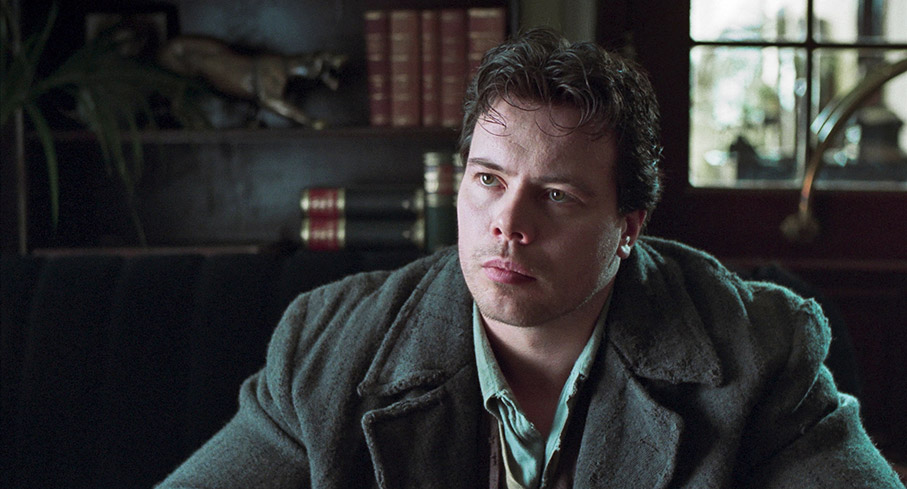
Although Herzog is known primarily for his fictional features – Aguirre, Wrath of God, The Enigma of Kaspar Hauser, Nosferatu the Vampyre, Fitzcarraldo, etc. – he has actually directed more feature documentaries than dramas and has also done a considerable amount of work for TV. One of the cool things about him is that he is so readily able to switch between these three formats, and so diverse are the range of subjects that he elects to explore that it would be a brave person who was willing to bet heavily on what he’ll make a film about next. One thing’s for certain, it won’t be a big commercial studio project – we’re not going to see Herzog at the helm of the next Star Wars or superhero movie. That said, I remain amused to this day that George Lucas once offered Return of the Jedi to David Lynch, whose story of the meeting he had with Lucas to discuss it still puts the widest of smiles on my face.** Anyway, in 1991, this hopping from drama to documentary and back again came to an end with the mountaineering drama, Scream of Stone [Cerro Torre: Schrei aus Stein], and in the ten years that followed, Herzog focussed exclusively on documentary features and TV movies, some of which – Lessons of Darkness, My Best Fiend and Wings of Hope included – ranks amongst his finest work. Then, in 2001, he made Invincible, his first dramatic feature in a decade, which despite being championed by several prominent critics, the Chicago Sun-Times team of Richard Roeper and Roger Ebert amongst them, met with a decidedly mixed response.
As the film begins, we are told in no uncertain terms that it is based on a true story. Although this is a common ‘inspired by real events’ get-out clause – a film that is simply ‘based on’ facts is theoretically not obliged to be historically accurate – it’s unusual to see it writ so large directly under the main title, making it look almost as if the full title is actually Invincible (based on a true story). The story in question is that of Sigmund ‘Zishe’ Breitbart, a Polish-born Jew who began life as a blacksmith and achieved worldwide fame as a professional strongman, at one point known as the ‘Strongest Man in the World’, but who died in 1925 at the tragically young age of 32.
The first piece of fact-fiddling comes in the shape of a caption informing us that we are in Eastern Poland in 1932, seven years after the real Zishe died. Here we find the film’s version of Zishe (Jouko Ahola) sitting with his young brother, Benjamin (Jacob Wein), who is telling him a story with a moral in its tail. When the two make a rare trip to a local restaurant – and we’re talking bare walls and wooden tables and simple fare here – they are hassled by a loud group of scumbags sitting at the table behind them. When one of these idiots is daft enough to lay his hands on Benjamin, Zishe makes good on his younger brother’s proclamation that he is not fat, as his tormentors claim, but immensely strong, and in the process wrecks a table and spills a whole keg of beer. When he humbly admits that he lacks the funds to pay for the damage caused, the restaurant owner tells him about a visiting circus, where money is being offered to anyone who can take on and defeat their resident strongman. Zishe makes short work of this unfortunate individual, and the following day is visited by Alfred Landwehr (Gustav-Peter Wöhler), a talent scout for a Berlin-based variety show. Initially resistant, in part because his blacksmith father Yitzak (Gary Bart) believes that this not the right life for a respectable Jew, Zishe decides to take this rare chance to exploit his natural talent and heads off on foot to Berlin, where he joins a successful troupe run by sternly authoritative Danish mesmerist and clairvoyant, Erik Jan Hanussen (Tim Roth), another real-world figure, albeit one that the real Zishe probably never met.
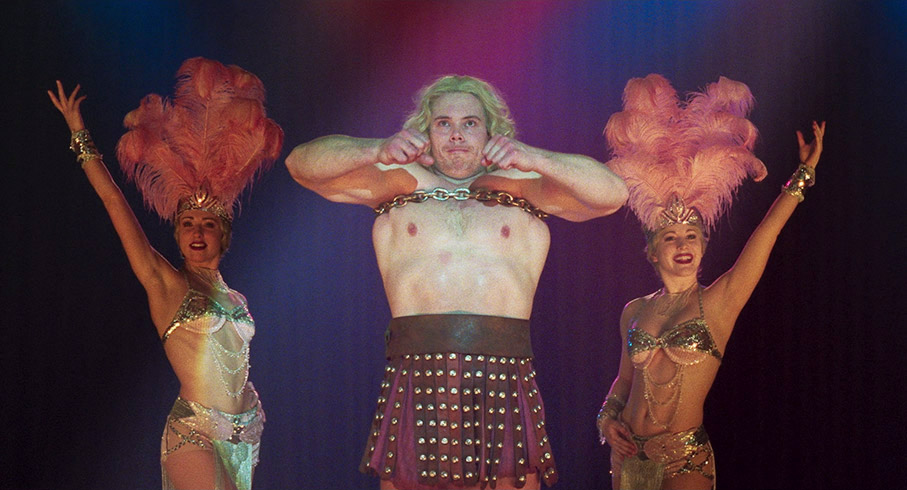
From the moment that the rowdy restaurant customers make the fact that Zishe and Benjamin are Jewish a key target of their insults, Herzog’s purpose in relocating the story to 1932 becomes clear. This was a pivotal point in German history, with the country in a state of political crisis and the Nazi party on the ascendence, its leader, a certain Adolph Hitler, just a few months away from becoming the country’s new Chancellor. Antisemitism was on the rise, and as the film progresses, Zishe’s metaphoric role in the story is made abundantly clear. Initially dressed by Hanussen as an Aryan God to become a symbol of Germanic power for the Nazi Sturmabteilung (uniformed paramilitaries, often abbreviated to SA) in the audience to cheer and idolise, when he eventually throws off his costume and proudly proclaims his Jewish heritage, he instead becomes an icon of Jewish resistance to the Nazi threat, detested by the Sturmabteilung who so recently fell at his feet but beloved countrywide by his own people.
For the opportunistic Hanussen, who becomes increasing vocal in his support for the Nazis and their leader, the fact that Zishe is a Jew is initially of no consequence if there is money to be made from his extraordinary strength and striking physique. He’s clearly aware of his audience as he dresses Zishe in the costume of a mythical warrior. “We will Aryanise you,” he tells him, adding tellingly after a pause, “Jews should never be as strong as you.” When Zishe reveals his true heritage, however, Hanussen angrily condemns him on stage, but behind the scenes is not remotely phased. “Do you know there was a line three blocks long when the box office opened this morning?” he asks Zishe the next m orning after pointing triumphantly to the front page story that the previous night’s revelation has prompted. “Three blocks. Three! It’s the Jews. They all want to see their new Samson.” Hanussen also has a symbolic role, one that becomes evident as he takes the stage and stands imposingly behind a microphone, where he is able to seduce his audience and both bend it to his will and take advantage of its mood. When Zishe reveals that he is a Jew and sends the Sturmabteilung into a frenzy of anger, Hanussen silences them in an instant and turns the revelation into promotional tool for his own skills as a hypnotist. When a fight later breaks out between a divided audience of Nazis and Jews, he strides off the stage into the auditorium and brings the pandemonium to a quick halt by commanding individual Sturmabteilung to stop what they are doing. As a skilled orator able to command, deceive and ultimately seduce an audience, Hanussen is representative not just of the rise of Hitler, but also of the populist politicians of today, dangerous charlatans whose desire for power is so great that their prime focus is never what would be good for the citizens they seem able to so easily hoodwink, but how to sell every failure as a triumph and redirect the blame for the suffering its causes onto others. As we later discover, however, there is more to Hanussen’s story than that of an opportunist sucking up to the people he has rightly predicted will soon be in positions of ultimate power.
As a drama, the film gets off to a hesitant start, the result of requiring non-professional first-timers to deliver dialogue in what is a second language both for them and their writer-director. There’s certainly a slight imbalance in the screenplay, with some of the dialogue and monologues so well written that it can leave some of the personal interplay feeling a little flat by comparison, and it will probably come as no surprise that real-life Finnish strongman Jouko Ahola was making his film acting debut as Zishe. The thing is, while his inexperience gives these first scenes a slightly awkward feel, as the film progresses, it actually works for his character, giving him an air of almost childlike innocence that makes him disarmingly easy to sympathise and even empathise with, as well as adding weight to his eventual embrace of his Jewish heritage. In the early scenes we see the world through Zishe’s eyes, as his journey to Berlin is aided by the kindness and friendliness of those he meets, and as he observes the theatrical world with awed delight. He also has one of the most charming smiles I’ve seen on screen all year. Seriously, how could you not like this guy? His fascination with the theatre’s pianist Marta is nicely balanced by the fact that she is played by Russian concert pianist Anna Gourari, who is also new to acting and tonally very much on Ahola’s wavelength. That she has become the plaything of her employer, who violently mistreats her and regards her more as a possession than a partner, sees that innocence and her underlying sadness cast her as a victim of circumstance, trapped in a relationship without which she would have no job and be forced to leave the country.
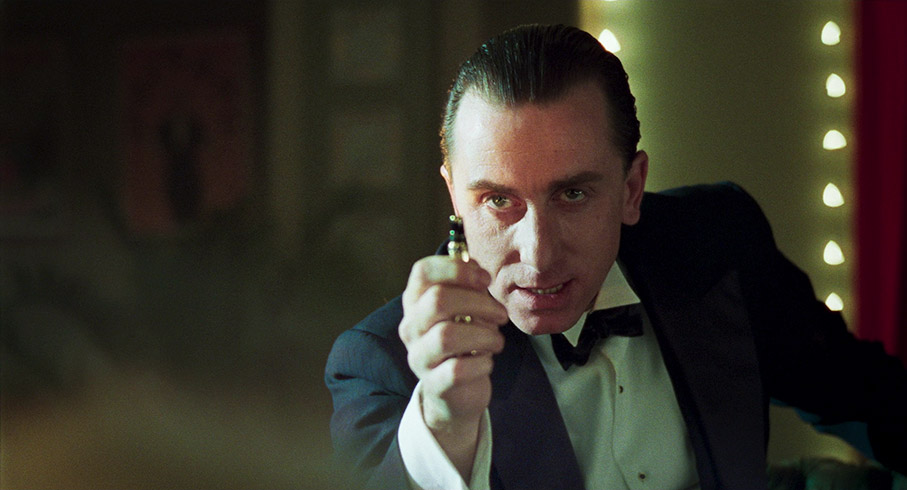
As Hanussen, Tim Roth is absolutely magnetic, his chiselled features and precision-tooled delivery of the film’s best and most subtextually rich dialogue making Hanussen both a fascinating and frightening figure, as much for what he represents as what he does. Roth’s casting is crucial here – from his piercing gaze as he hypnotises an audience member into psychosomatically burning herself or commanding an angry group of Nazis to cease fighting, Roth always cuts a most convincing figure. When he walks on stage with his slicked-back hair, stern expression and black cape, he looks like a classical vampire, while as a trusted clairvoyant, he is consulted by Himmler on Hitler’s behalf for his predictions on the future fortunes of the party. His ambition to be part of the rising Third Reich, meanwhile, is given physical form through the expansion of the inner sanctum in which he holds seances for invited guests – one whose circular design and backlit tabletops are based directly on one used by the real-life Hanussen but whose dreamy jellyfish aquarium background is a Herzog creation – into cathedral-like hall of similar design in which he expects to become Hitler’s Minister of the Occult. So good a performer is Roth that when things take a darker turn for Hanussen, I really felt for him, an emotional response inspired in part by an awareness of how real-world events were already starting to play out.
In the opening scenes, Ahola’s inexperience as an actor does show and give a couple of the sequences the feel of a first rehearsal, and just occasionally the film’s symbolism is a little on-the-nose. The most unsubtle example of this comes in the form of a dream experience by Zishe, in which thousands of slow-moving crabs are about to be crushed by an oncoming train, while Zische stands on the shoreline amongst the animals holding a sledgehammer, a symbol of Jewish strength that will ultimately prove no match for the steadily approaching Nazi locomotive. There’s also a turn of events that initially struck me as a little unlikely, at least in the context of the characters and the story. Hanussen has arranged a gathering of higher-ranking Nazis and other influential contacts on board a boat, and Marta has asked Zishe to accompany her as her guest and unofficial protector. When Hanussen gets into an argument with Marta and roughs her up, Zishe intervenes by grabbing him, lifting him above his head and making moves to throw him overboard (man, this guy is strong). He’s prevented from doing so by the wily intervention of influential guest, Count Helldorf (played the always wonderful Udo Keir), and after putting Hanussen down, Zishe accuses him of being a fraud and Hanussen pulls a gun on him. How does Helldorf diffuse this? He suggests that Zishe be asked to prove his claims in court, and for some reason the furious Hanussen agrees to this. On my first viewing, I didn’t buy this, particularly given the risk it places Hanussen at, albeit for reasons that at this point have yet to be disclosed. Only on my second viewing did I recall that Helldorf is Berlin’s Chief of Police and appreciate that the argument has attracted a crowd of potential witnesses. It also occurred to me that by this point in his career, Hanussen’s arrogance has made him blind to the very idea that he might be in any way vulnerable.

Despite an early uncertainty on my part, I found myself being almost unconsciously seduced by Zishe’s journey, only becoming aware that it had been steadily increasing its grip when the process was complete. A second viewing helped to clarify some of the key stages of this progression: the audience-eye view of Zishe’s easy victory over the circus strongman; his late-night whispered conversation with Benjamin, subtly foreshadowed by a slow pan over the sleeping family and the realisation that only the two brothers are still awake; the help to move a stuck cart that Zishe gives two farmers on his journey to Berlin, one of whom cackles cheerily at everything Zishe says; the look of wonder on his face when he first catches sight Marta; the way Roth commands almost every scene in a reflection of the authority Hanussen has over those who work in his show… I could go on.
I can appreciate why critics were a little sniffy about Invincible on its release. The fact that it was the first dramatic feature from a filmmaker of Herzog’s calibre for a decade seems to have created expectations that the film was never designed to meet. I’ve certainly seen it described as a lesser Herzog movie and even an oddity, which for me seems a strange thing to say about a director whose career is liberally peppered with fascinating oddities and whose choice of projects has always been eclectic. That it’s very occasionally a little rough around the edges is almost a Herzog signature, as is the film’s fascination with those living or working on the fringes of society and a cast in which professional actors converse with untrained first-timers. Do I think it’s a misjudged masterpiece? I’d have to say no, but I also don’t believe that it’s anything close to the misfire that it’s been dismissed as in some quarters. For me, it proved a captivatingly told tale whose fictionalisation of real-life characters I was previously unaware of intrigued me enough to prompt my own research and subsequent appreciation of the true-life details that are authentically recreated here, including how Zishe and Hanussen’s individual stories conclude. Gorgeously shot by Herzog regular Peter Zeitlinger and featuring a beautifully emotive score by Hans Zimmer and Klaus Badelt, Invincible is a film that, like so much of Herzog’s work, does not play to convention or expectations, while its quietly sobering impact ultimately stems from how history tells us that world events subsequently played out, and is frankly all the more effective for choosing not to explicitly tell us what we already know.
Sourced from 2K restoration by Farbkult, supervised by director of photography Peter Zeitlinger and framed in its original aspect ratio of 1.85:1, the 1080p transfer on Indicator’s Blu-ray is seriously impressive, although it does take a short while to really show what it can do. The early scenes are shot with a documentary flavour, with naturalistic lighting and muted colours, but once Zishe begins his journey to Berlin, the rich greens of the fields give a flavour of what is to come, and as soon as the troupe of dancing girls takes the stage in the theatre, the vibrancy of the colour just leaps from the screen. In the special features it’s made clear that this was a deliberate decision to visually differentiate the real world from which Zishe had come from the manufactured one in which he finds fame, and that’s handsomely captured here. The contrast is impeccably graded, with solid black levels and a very nice tonal range, while detail is crisply rendered throughout. The image is clean and there is a fine film grain visible.
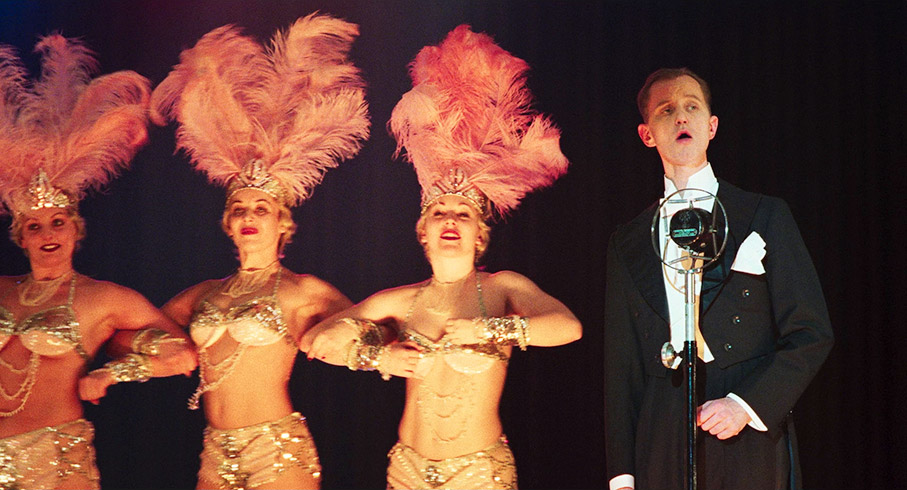
Although made in Germany by a German director and featuring many German actors, Invincible was shot in the English language, the reasons for which are outlined in the extras and do make sense. This track is available in DTS-HD Master Audio 5.1 surround and Linear PCM stereo 2.0. Apparently, the 5.1 track is how the film originally played and sonically it’s definitely the superior of the two, having a richer feel and finer fidelity at each end of the dynamic range, though I was not able to detect any activity from the rear speakers, which I would have normally expected to come to life in theatre scenes on a true surround mix.
The film was also released on home turf in a German dub (from what I can gather, German audiences favour dubs over subtitles when it comes to foreign language films), one Herzog himself carefully cast and personally supervised to ensure it was of the highest quality. For those of us who know the sound of Tim Roth’s voice by heart, the nasally German one he’s given here takes a bit of getting used to, but in all other respects this is a solid job and is certainly well performed, though when characters are photographed in close-up of mid shot, the mismatch of voice and mouth movements is still visible. This is also a DTS-HD Master Audio 5.1 track, and sonically is very similar to the English 5.1.
There are three optional English subtitle tracks. The first is for the deaf and hearing impaired and has to be activated manually. The second is for the German dub, and this kicks on by default if that version is selected to be played, but can be switched off with the remote if preferred. The third provides a translation of the audio commentary, which is conducted in German, and again can be manually disabled if your language skills are up to the job.
Audio Commentary with Werner Herzog and Markus Ölshlänger
Oh, this is how I like my filmmaker audio commentaries to be. Here, writer-director Werner Herzog converses with Markus Ölshlänger – about whom I have frustratingly been unable to find any information – about the film and its making, and does so without the sort of fawning over his own work that you’ll find on so many such commentaries. What he does do is provide a mountain of information about the production, including the professional and non-professional actors, the locations, the technique of shooting in long takes, the real-life Zishe Breitbart and Erik Jan Hanussen, the production design, the scenes that were removed from the original three-hour first assembly, the small roles taken by crew members, and much, much more. He describes Tim Roth as “one of the greatest actors of our time” (no argument here) and tells a story that I’ve heard elsewhere about how when filming Roth performing his hypnosis technique (which Herzog taught him) to camera, cinematographer Peter Zeitlinger slipped into a daze and had to be propped up by his director. He reveals that Roth worked at a considerably reduced fee because he had wanted for some time to work with the director, and that Hans Zimmer worked on the score for free because Fitzcarraldo was the film that had inspired him start working as a score composer and ultimately changed his life. There’s an amusing story of a woman who lived in one of the houses around which they were filming who wandered into their period market set with a plastic bag and an umbrella to do her weekly shop, and it’s here that I learned Zishe’s father is played by Gary Bart, a direct descendant of the real Zishe and the man who first brought this project to Herzog. This is just a sampling of the content here. A terrific inclusion.
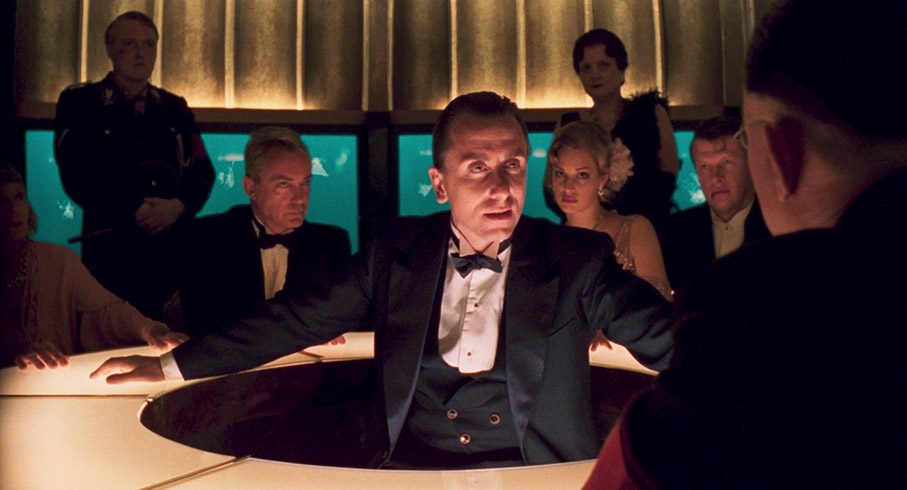
Peter Zeitlinger: The Road to ‘Invincible’ (26:22)
A new interview with Herzog’s regular Czech cinematographer, Peter Zeitlinger, who looks back at how his life was changed by the Russian invasion of his home country, how a move to Austria led to him learning to speak five languages, how he became fascinated by film and made his own animated shorts with a borrowed 8mm camera (three of which are included on this disc), and how this helped to get him into film school in Vienna. This brought him geographically closer to Herzog, whose Heart of Glass had been instrumental in shaping his love for film, and he recalls how a letter written to the director later led to them working together on a short film created to mark 100 years of cinema, and their first feature documentary collaboration, Gesualdo: Death for Five Voices. Other collaborations get some coverage, with Invincible inevitably being the principal focus. There’s some revealing stuff here, including the use of slow camera movements, the process of getting soft light at a time before dedicated soft lamps were available, details of how a final dream sequence was created, and Herzog’s intense dislike of storyboards – when Zeitlinger presented one to him for a special effect needed for the dream sequence, Herzog screwed it up with the proclamation, “No storyboards on my set!” The interview is conducted in English and is another most worthwhile inclusion.
Archive Interview with Peter Zeitlinger (12:55)
An earlier interview with cinematographer Zeitlinger, conducted in German on location during the Invincible shoot by the production’s stills photographer, Beat Presser. Here, he talks about Herzog’s approach to filming (it comes as no surprise that he dislikes bureaucracy, order and planning), shooting the auditorium fight scene, the importance of light in the film, how he and Herzog took visual inspiration from old photographs rather than old films ( he explains why, and it makes complete sense), shooting in small spaces with a small crew, and more. Another useful insight into the making of the film.
Location Footage (2:52)
Filmed by Beat Presser, this single-shot, handheld wander round what looks like the location used for the Zishe family home shows how it was before the production design crew got to work on it.
UK Theatrical Trailer (2:16)
A well assembled and rather seductive sell, though it does emphasise the symbolism of that dream sequence by underscoring it with dialogue that spells out its meaning.
German Theatrical Trailer (2:10)
Another solidly assembled and persuasive trailer, albeit with a German dub and narration and notable for including a couple of the film’s most telling lines and a shot from a dream sequence just before the end. This appears to have been sourced from videotape.
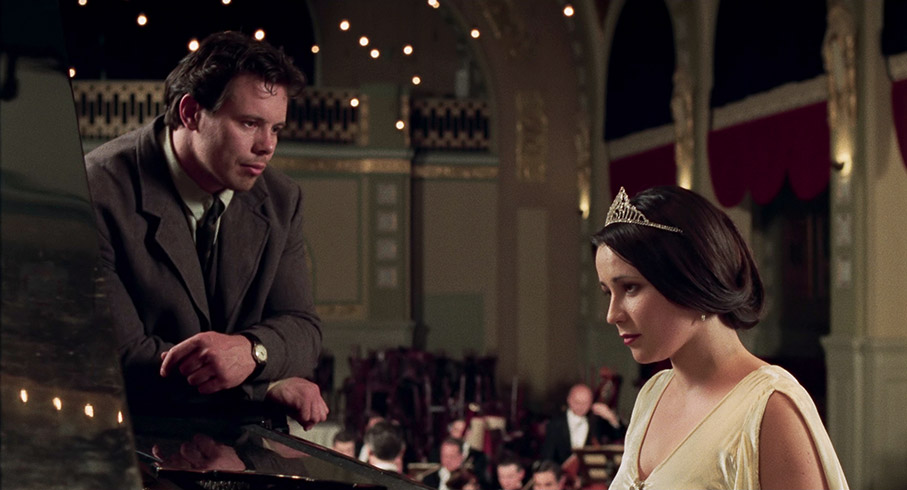
US Theatrical Trailer (2:12)
Essentially, the same as the German trailer but of better quality and with an American voiceover and English language dialogue. Whether this edit was created by the German distributor or its US counterpart I can’t say for sure, but according to the IMDb, the film was first screened in Germany almost a year before it’s limited USA release, so draw your own conclusions.
Image Gallery
68 screens of promotional stills that do not look anywhere near as good as the transfer of the film itself, some much nicer monochrome behind-the-scenes imagery (plus a few colour ones), press book page scans, and a couple of posters.
Peter Zeitlinger’s Early Short Films
A surprise inclusion, three early 8mm films made by cinematographer Peter Zeitlinger, short experiments with the medium that helped him get into film school.
Katharina Blum (1978) (1:56)
A light-hearted homage to Volker Schlöndorff and Margarethe von Trotta’s The Lost Honour of Katharina Blum, in which a well-dressed young man is startled by what he reads in a newspaper that then assaults him in an almost Svankmajer-esque piece of stop motion pixilation. In rather good shape for an 8mm short, despite some serious jitters.
Experiment Rayner’s Garden (1978) (1:57)
A single shot experiment in which stop motion pixilation is employed to move an individual around a garden location in ways that wouldn’t be possible in real time, a work “inspired by the master of minimalistic film, Peter Kubelka.” Having played such games with 8mm cameras and the single frame function in my art school days, I found this rather fun.
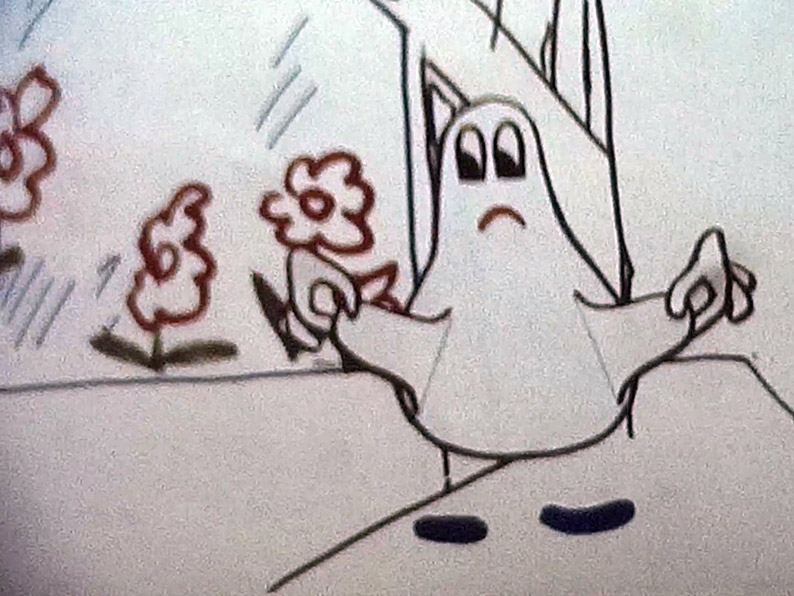
Geburtstag [Birthday] (1979) (7:41)
A man wants to buy a flower for his girlfriend for her birthday but doesn’t have the required funds, so comes up with a rather extreme plan to procure one in this technically wobbly but inventively designed and animated 8mm short.
Booklet
After the film credits, we have a persuasive essay in support of the film’s merits by respected author of many film books, Jason Wood, who also handled its UK theatrical release on behalf of the now defunct FilmFour distribution arm. Next are extracts from an interview with Werner Herzog from Paul Cronin’s 2002 book, Herzog on Herzog, in which the director talks about coming to the project and relocating Breitbart’s story in the 1930s, the real life Erik Jan Hanussen, and his fascination with strongmen. Also included here is a copy of the letter that Herzog sent Russian pianist Anna Gourari, which doesn’t so much ask her to be in the film as inform her that she will be – “May I say again,” Herzog concludes, “that I cannot contemplate a refusal from you.” This is followed by an unattributed interview with Tim Roth from the film’s press kit, in which he talks about working with Herzog on the film, his admiration for the director’s work, the character of Hanussen, and working with first-time performers Jouko Ahola and Anna Gourari. A collection of fascinating press clippings on the real Siegmund ‘Zishe’ Breitbart is followed by some extracts from three contemporary reviews and main credits and summaries for the three included Peter Zeitlinger short films.
I appreciate that some will not get as much out of Invincible as I did, and I have a feeling that my own expectations for it, perhaps influenced by the sort of negative reviews I usually try to avoid, were the reason I took so long to sit down and watch it. I’m so glad that I did. I was almost invisibly drawn into it on my first viewing, and by the third, all of my minor reservations had effectively been washed away. I salute Indicator for procuring and releasing this one, especially with such a strong transfer and such interesting special features, the cream of which is the excellent Herzog commentary. For those who are game, warmly recommended.
|